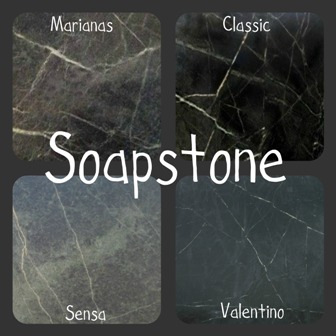The only maintenance required for soapstone (steatite) is the application of mineral oil to enhance the natural darkening process the stone goes through. Once mineral oil is applied, the stone will turn into a very dark charcoal gray, sometimes black. Often times, varieties of soapstone will keep a hint of green. Steatite (soapstone or soaprock) is virtually heat proof and used in the construction of masonry heaters because of its excellent thermal qualities. It is also used in creating pizza stones, cooking pots, oven interiors and numerous related applications. You can take a pot right from your stove and place it on your soapstone countertops without harm.
Oiling a Soapstone Countertop
We recommend oiling your countertops to ensure that the stone will evenly darken. The oil is not sealing or protecting the stone, it is only “speeding up” the natural darkening process that steatite (soapstone) goes through. Soapstone is non-porous and, unlike marble and granite, does not need to be sealed.
There isn’t a set rule of how often you should oil the countertops. Oiling too little or too much will not damage the stone in any way. We recommend oiling the countertops as soon as the previous coat of mineral oil has started fading away (evaporating). Once you oil the countertops for the first time you will see the stone will become much darker. A few days from the first oiling, most soapstone will lighten back up. You can re-treat your countertops every time this happens. The soapstone will take approximately 3 coats of mineral oil to reach its final color, getting darker after every oiling. Every time you oil your countertops, the stone will hold the oil longer than the last time, until about the 6th or 8th month the stone will stay permanently dark.
You can oil the countertops any way you like. You can spread some oil on the counters, then rub it with a rag, or you can put the oil on the rag and oil the counters. To make the next oiling easier, keep the same rag in a zip lock bag, you will see that the rag will soak in the oil and spread easier on the countertops.
Immediately after you’ve oiled the soapstone, you can remove all the excess, until the countertops no longer feel slick. There is no such thing as “let the oil soak in”. Remember, soapstone is impermeable, nothing penetrates the surface.
Cleaning a Soapstone Countertop
Any common household cleaner can be used to clean soapstone counter surfaces. Chemicals and acids do not harm it. However, we do recommend that you use regular soap and water because harsher solvents may remove the mineral oil treatment, therefore generating more maintenance. Soapstone, being softer than granite and marble, is also more prone to scratches. The great advantage is that any scratches can be easily removed with a light sanding and/or mineral oil.
Removing Scratches
Eventually the countertops will get scratched. Most scratches can be hidden by lightly applying some mineral oil. If you get a deep scratch in there, you will need to do some sanding. With a small piece of 120-grit sandpaper, sand the scratch area in a circular motion until the scratch is almost gone, then using a 220-grit sandpaper do the same thing but this time using water. Clean up the countertop and oil in that section again. Sanding will remove the mineral oil, and remember that the stone will take 3 coats to reach the final color. You may notice a slight color difference on that spot. Do not worry, you can oil in the morning, then again in the afternoon and so on until the color evens out.
© Crocodile Rocks Inc.


